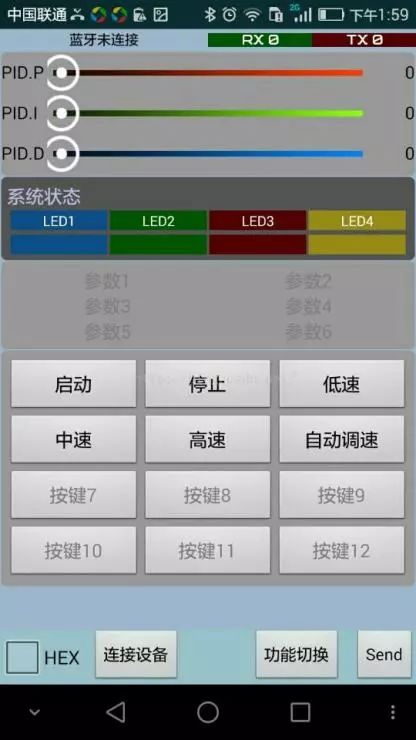First buy a Bluetooth module, I bought the HC-06, download a Bluetooth serial debugging assistant on the phone, equivalent to the UART serial port communication microcontroller, use BUFF to obtain the received data, here only need to pay attention to a problem, that is, testing Coding, if the APP sends 0xFF, (APP Bluetooth Serial Debugging Assistant already supports manual setting of button names and sent characters) But the Bluetooth module is likely to receive 0xF8, 0xF2, 0xFE. So here we should first test the coding. HC-06 generally has 5 ports, RX, TX, VCC, GND, AT, AT here we do not use, refers to change the password, the default password is generally 1234 or 0000, connect VCC and GND, then RX and TX Respectively and the one-chip computer's TX and RX are connected (is P3^0 and P3^1, must remember to connect to the contrary), then we according to the general UART serial communication is OK, the inspection receives the BUFF data, then the switch can realize the corresponding Features. #include #define uchar unsigned char #define uint unsigned int Sbit PWM=P1^0; Sbit DSPORT=P3^7; Void Ds18b20ReadTemp(); Void UsartConfiguration(); Unsigned int temp=0; Unsigned char zhuanshu=20; Unsigned int cnt=0; Unsigned char receiveData; Unsigned int dingshi=0; Unsigned char min=1; Void main(void) { Unsigned int i=3000; UsartConfiguration(); While(1) { If(cnt>=3000) { Cnt=0; Ds18b20ReadTemp(); //3s detects temperature once } Switch(receiveData) { Case 177:ET0=1;zhuanshu=20;receiveData=0;break; // Number 1 fan start Case 178: zhuanshu=0;while(i--);ET0=0;receiveData=0;break; //The number 2 fan stops because the IO port is high by default so let zhuanshu=0 Case 179: zhuanshu=30;break;//number 3 low Case 180: zhuanshu=50;break;//number 4 middle block Case 181:zhuanshu=70;break;// digital 5 high gear Case 182: // Digital 6 automatically adjusts the speed according to the temperature { If(temp<3200) { Zhuanshu=25; } If((temp>3200)&&(temp<3300)) { Zhuanshu=30; } If((temp>3400)&&(temp<3600)) { Zhuanshu=50; } If((temp>3200)&&(temp<3300)) { Zhuanshu=60; } } break; Case 183: //Timed number digit 7 { Static dingshi=0; If(dingshi>=60000) //A benchmark for 1 minute { Min--; Dingshi=0; If(min==0) { ET0=0; Zhuanshu=0; } } Break; Case 184: receiveData=0;min++;break; // increase time number 8 Case 185: receiveData=0;min--;break; //decrease time number 9 } } } } Void UsartConfiguration() { SCON=0X50; //Set to work mode 1 TMOD=0X21; //Set counter work mode 2 PCON=0X80; // Double the baud rate TH0 = 0xFC; TL0 = 0x66; TH1 = 0XF9; / / counter initial value settings, pay attention to the baud rate is 9600 TL1=0XF9; ET0=1; ES=1; //Open receive interrupt EA=1; //Open total interrupt TR1=1; TR0=1; //Open the counter } Void Usart() interrupt 4 { receiveData=SBUF; //Outgoing received data RI = 0; // Clear Receive Interrupt Flag } Void Time1(void) interrupt 1 //3 is the interrupt number 1 of timer 1 Interrupt number 0 of timer 0 External interrupt 1 2 External interrupt 2 4 Serial port interrupt { Static unsigned char timer1=0; TH0 = 0xF6; //Reassign initial value TL0 = 0x66; Timer1++; Cnt++; Dingshi++; If(dingshi>=60050) { Dingshi=0; } If(timer1>100) //The PWM period is 100*0.5ms { Timer1=0; } If(timer1 { PWM=1; } Else { PWM=0; } } Void Delay1ms(uint y) //Delay program { Uint x; For( ; y>0; y--) { For(x=110; x>0; x--); } } Uchar Ds18b20Init() // temperature subfunction { Uchar i; DSPORT = 0; //Pull the bus low 480us~960us i = 70; While(i--);//delay 642us DSPORT = 1; //then pull up the bus, if the DS18B20 reacts it will pull the bus low after 15us~60us i = 0; While(DSPORT) //wait for the DS18B20 to pull down the bus { i++; If(i>5)//wait >5MS { Return 0;//initialization failed } Delay1ms(1); } Return 1;// initialization was successful } Void Ds18b20WriteByte(uchar dat) { Uint i, j; For(j=0; j<8; j++) { DSPORT = 0; // Pull the bus low 1us before writing one bit of data i++; DSPORT = dat & 0x01; // Then write a data starting from the lowest bit i=6; While(i--); // delay 68us, duration 60us minimum DSPORT = 1; // Then release the bus, at least 1us to the bus recovery time to write the second value Dat >>= 1; } } Uchar Ds18b20ReadByte() { Uchar byte, bi; Uint i, j; For(j=8; j>0; j--) { DSPORT = 0;//first pull the bus low 1us i++; DSPORT = 1;// Then release the bus i++; i++;//delay 6us waiting for data stabilization Bi = DSPORT; //Read data, read from lowest bit /* Moves byte one bit to the left, and then shifts the first 7 bits from the right to the right bit. Note that the zero is removed after the move. */ Byte = (byte >> 1) | (bi << 7); i = 4; // After reading, wait 48us and then read the next number While(i--); } Return byte; } Void Ds18b20ChangTemp() { Ds18b20Init(); Delay1ms(1); Ds18b20WriteByte(0xcc) ;// Skip ROM operation command Ds18b20WriteByte(0x44); //temperature conversion command // Delay1ms(100) ;// Wait for the conversion to succeed, and if you are always brushing, then do not use this delay } Void Ds18b20ReadTempCom() { Ds18b20Init(); Delay1ms(1); Ds18b20WriteByte(0xcc) ;// Skip ROM operation command Ds18b20WriteByte(0xbe);//Send read temperature command } Void Ds18b20ReadTemp() { Float tp; Int temp1 = 0; Uchar tmh, tml; Ds18b20ChangTemp();//write conversion command first Ds18b20ReadTempCom () ;/ / Then wait for the conversion to send the read temperature command Tml = Ds18b20ReadByte();//Read temperature value total 16 bits, read low byte first Tmh = Ds18b20ReadByte(); //Reread high byte Temp1 = tmh; Temp1 <<= 8; Temp1 |= tml; If(temp1< 0) { Temp1=temp1-1; Temp1=~temp1; Tp=temp1; Temp1=tp*0.0625*100+0.5; } Else { Tp=temp1; Temp1=tp*0.0625*100+0.5; } Temp=temp1%10000; } Semiconductor Parts Semiconductor Parts,Semiconductor Parts Solid-state capacitors,Power Semiconductor Parts YANGZHOU POSITIONING TECH CO., LTD. , https://www.cndingweitech.com